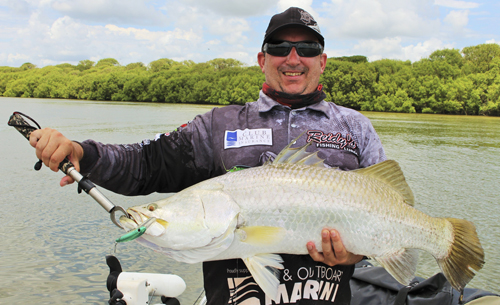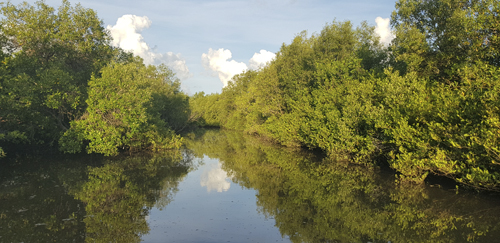Big Barra Run Off Fishing. By Craig Latimore
The Northern Territory runoff is truly a wonderful beast and usually stretches from February to sometime in May. During the preceding months, there is a mix of massive storms, monsoons and cyclones dumping their lifeblood onto the various floodplains across the NT. Paving the way for the reproduction and growth of a huge biomass that the mighty barramundi calls food. And it’s when the rains ease and the floodplains start to fall, all that food flows into the many runoff creeks and rivers. What follows is a feast that could only be matched by the Mother in Law at a pie sale.
So if you want to come to the NT to get yourself a piece of the pie, hopefully I can shed some light on the essentials that anyone travelling from down South will need to make the trip of a lifetime a barra slam dunk. Firstly I think you need to make a rough plan on how the trip is to be undertaken. Are you going to tow your own boat up? Will you be fishing on a charter? Or will you hire a boat? A good option for first-timers is to go on a charter to learn as much as they can, and then either use their own boat or hire one for the rest of the trip.
I believe that if it is your first time, the barra charter is the best option. These guys are absolute guns and sell out a long time in advance, so book early. It will not be cheap but they have so many advantages over any other option. If you do an extended charter of 3-7 days, you will no doubt be accommodated on a live aboard very close to the fishing grounds. There are several that spend the entire run off at the mouth of Sampan Creek, Tommycut Creek, East Alligator, Finniss River, Daly River and some leave Darwin to head down the Moyle system (just to name a few). They have a/c, hot showers, freezers for take home catch, beds away from fierce late storms and the barrage of insects. Plus ample room to keep your beer icy cold. But the massive advantage is that these guides virtually live at these spots during the runoff. They know where the bait is, where the barra are feeding, and they can get you there within minutes of waking up and put you into the prime position.
Hiring a boat can also be a great option. The boats are ‘NT Tough’. Boats up to around 7m with heavy duty trailers, modern sounders, electric trolling motors, fridges, eskys etc. to make your fishing experience a successful one. You also do not need a boat license to hire a boat in the NT.
Now if you are intending to tow your pride and joy all the way to Darwin, there are a few things that you will need to take into consideration. Firstly make sure that your boat and trailer are in tip top condition. And pack the essential tools and spares to replace wheels, tyres, bearings, springs etc. on the side of the road. You don’t want to be in the middle of nowhere waiting a day for a tow truck to come and get you. Also, consider getting yourself some good recovery gear. Some ramps have stretches of dirt road that have caught many by surprise. And lets’ face it, if you have spent thousands of dollars to get there for a week of fishing, is it really worth it to be sitting in a bog and missing a tide window and full days fishing? Road access is also another vital consideration. Often there are large stretches of National Highway that become impassable during the early runoff.
For me, tides and fishing tactics go hand in hand. Learn your tides for the proposed area you wish to fish. Getting it wrong could see you turn up with no water to launch, or worse, launch and have yourself stuck in the mud in sight of the ramp for several hours before the tide comes back in enough to get out of the water. Tide tools that I use are the bom.gov.au and willyweather.com.au. Another great source of local information is the online forum ‘Fish Finder Forum’ (fishingterritory.com) and the Fish Finder Book. The fish finder book will give you not only information on ramps and usable tide height needed to get over rock bars etc., but it will also give you maps of areas and some general information on how to fish it. It’s something that I used a lot when I first moved to the Territory.
Ok, so here’s a spanner. One place that is arguably the most iconic barramundi runoff spot is Shady Camp. During times of high flood, you can launch at any time. But there will be a point sometime during either March or April that the flood water will fall far enough that you will need tidal influence to use it and traverse the first few hundred metres downstream. And you can’t get out of the boat because you will sink into the mud up to your waist. Plus it’s home to the largest population of Saltwater Crocodiles anywhere in the world.
Now, when I say fishing tactics and tides go hand in hand, this is what I mean. And don’t think that this is iron clad, it’s a guide and a general starting point. Usually, during neap tides you want to be trolling the mouths of the larger creeks like Sampan Creek and Tommycut Creek at Shady Camp (just to name one spot) across the low and pretty much the entire run in tide. Start out really wide (1-2km) and do short troll runs of about 500m, plotting where you mark fish on your sounder. Eventually, some salt water will push in with the tide and back up the fresh water runoff coming out of the creek. Fish usually follow this push in so you need to be well aware of what’s on your sounder and follow the fish into the creek. Concentrate efforts on the dirty lines that are created when salt water and fresh tannin coloured runoff water collide.
On the larger spring tides, you should consider leaving the bigger creeks and getting into the many smaller coastal creeks that are located throughout many of the large NT bays. Apart from the fact that you need higher water to get over the mud flats and into these creeks, when there is lots of runoff you will also need a much higher tide to back that runoff water up and slow it down. This creates large eddies which can create feeding frenzies as huge schools of mullet and other bait make their way out of the creeks. When the runoff is much less, you may also get access to these creeks for great fishing on the neap tides, but the time to get in and get out is much smaller. Unless you choose to “lock in” over the low tide. A master stroke if it turns out to be a fish frenzy, but if there is nothing, you will have several hours of mosquito frenzy before you can get out again.
Now lets’ talk tackle. I personally use two Wilson Venom PE 3-5 6kg bait casting rods with a Shimano 200 and 300D Calcutta’s for trolling. And for casting, I use a Daiwa Tatula 2-5kg bait casting rod matched with a Daiwa HRF PE 7.3R-TW. There are many different options for great barra combos for all scenarios and price ranges. My advice is to talk to one of the great tackle stores in Darwin and buy the best that you can afford. You don’t need super expensive gear to catch great barra. The best two tackle stores in Darwin, in my opinion, are Craig’s Fishing Warehouse and Fishing and Outdoor World. Everyone that works there are seriously good fisherman and know a lot more about barra fishing than myself. With line, you should look at 30lb braid for main line and 50-60lb fluorocarbon as a leader. However, while fishing in those small coastal creeks that are only a few metres wide and all snagged up, there is a real possibility of connecting with a 120cm plus fish. Some guides use really beefed up gear like Venom Black Bass rods, 80lb braid and 100lb leader in an attempt to stop these raging chrome missiles from making you look stupid. Standby for burnt thumbs.
What are the best barra lures? Well, you could probably ask the 50 best barra guides in the country that same question and get 1000 different answers. So I will just give you a small insight on what I use and
find extremely effective. Basically, you need to cover your trolling and casting needs, in both hard bodies and soft plastics. And sometimes, size really does matter. Elephants eat peanuts, but sometimes those big girls want 7 inch plus plastics and hard bodies 200mm plus.
For trolling 2-5m water depth, I am a huge Reidy’s Lures fan. They consistently catch the largest fish during the Barra Nationals and Barra Classic held on the Daly River. And on my boat, they have accounted for 11 fish over 1m, and 4 of those were 119-122cm…Genuine horses. Without a doubt, you need to have Big B52’s, Big Ass B52’s, Big Ass B52 200’s, Judges and Renegades. These are all different lengths and depths. And must have colours are Kryptonite, Cuss, Tropical Thunder, 008, M10, M15 and Slimy Mackerel. See reidyslures.com.au for more details.
Trolling shallower than 2m of water, and yes, you will find plenty of large barra lurking in 1m of water, I change to the large YoZuri Crystal Minnows, Bomber Longshots and 2 Deadlys. And don’t be fooled into thinking that the 2 Deadly is just a popping lure. Slow troll that in very shallow water and hang on!
When you are casting at eddy’s, run off creeks up a river or in the small coastal creeks you can also use any of the previously mentioned lures for great success. In saying this, you should also have a few plastics in your arsenal. I use Airgaps, Zerek Flat Shads and Swim Baits. And from Reidy’s you will be well served to have a selection of Fish Snakz, Reidy’s Rubbers and Reidy’s Weedies. Also, pack a few larger plastics around 7-10 inch. If you find large barra boofing really big mullet, you will be hard pressed to entice a strike on a 4-inch plastic.
One of the best pieces of advice I can give you is “Don’t be lazy”. If you have a fray on your leader, cut it off and retie your lure. If you straighten a hook or open a ring (and you will), replace it. I always keep a selection of trebles and rings ready to go. Make sure your knots are sound and tested before your lure hits the water. If your leader is becoming short, cut it off and do it again. Some of these things are a serious pain in the ass, especially in a hot bite. But look at it this way. You have just possibly spent several thousand dollars on a fishing trip of a lifetime. You see a slightly open ring, or you have repeatedly throughout the day straightened a hook. And then a 60 pounder jumps on and you lose it due to that weakness in the terminal tackle. Would you be able to forgive yourself?
Lastly, but definitely not least, is have fun and be safe. There is a huge population of crocs in the NT. Assume they are everywhere. If a big croc takes an interest in your boat, then move. Big crocs will attack your boat if they feel as though you are threatening their food source. No fish is worth your life. Make sure you have all the safety gear in date, including a registered EPIRB. And take plenty of water and fuel. Some of the coastal creeks are over 100km from the nearest ramp, and if you were to get stuck on a mud bar, it can be several hours before you get to float back off. Or if your engine breaks down, an EPIRB might be the only thing to get yourself rescued
I would like to reiterate that this advice is not hard and fast. But rather a bit of a guide to get first timers started on the right path, or seasoned run off fishermen a different perspective to consider. When you make the journey to the NT, good luck. I can’t wait for the runoff. It’s going to be awesome





